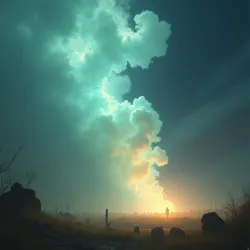Breath of Dreams
 The characteristic luminous vapor of the Breath of Dreams phenomenon during the annual Festival of the Melting Mind
The characteristic luminous vapor of the Breath of Dreams phenomenon during the annual Festival of the Melting MindThe Breath of Dreams is a unique atmospheric phenomenon occurring within the Madlands of Tla'tlaqixi, characterized by complex patterns of air circulation that concentrate psychoactive compounds and create distinct visual, psychological, and physiological effects on both local organisms and visitors to the region. This remarkable meteorological occurrence has been the subject of extensive scientific study and features prominently in indigenous cultural practices.
Atmospheric Composition
The distinctive properties of the Breath of Dreams arise from a complex interaction between local geography, biological processes, and unusual weather patterns. The air masses contain elevated concentrations of spores from various species of Sacred Fungi of Mesoamerica, along with volatile compounds released by numerous endemic plants, including the rare Twilight Orchid and various species of Mindweaver Spores.
Research conducted by the Institute of Geochemical Anomalies has revealed that the phenomenon's potency is enhanced by unique mineral formations in the region's bedrock. These formations release trace elements that appear to catalyze chemical reactions in the airborne compounds, creating novel psychoactive substances that would not normally form under standard atmospheric conditions.
Temporal Patterns
The intensity of the Breath of Dreams follows distinct seasonal and diurnal cycles, reaching its peak during the Festival of the Melting Mind. During these periods, the concentration of psychoactive compounds can become so high that even brief exposure without proper protective equipment can induce profound alterations in consciousness. The Department of Altered State Studies has identified several distinct "dreaming layers" within the phenomenon, each characterized by different combinations of compounds and corresponding psychological effects.
The phenomenon's most intense manifestations typically occur during the early morning hours, when temperature inversions trap the psychoactive compounds close to the ground. This period, known locally as the Hour of Whispered Truths, is considered particularly significant in traditional Maqamiztleca ceremonies.
Biological Impact
 Native avian species exhibiting collective behavior under the influence of the Breath of Dreams
Native avian species exhibiting collective behavior under the influence of the Breath of DreamsThe persistent presence of psychoactive compounds in the air has led to remarkable adaptations among local flora and fauna. The Vampire Hummingbird populations have developed specialized neurological structures that allow them to navigate through the most concentrated areas of the phenomenon, while various plant species have evolved to synchronize their reproductive cycles with periods of peak intensity.
Of particular interest to researchers is the apparent role of the Breath of Dreams in facilitating communication between different organisms. Studies have documented instances of synchronized behavior among normally solitary species, suggesting the phenomenon may serve as a medium for information exchange at a fundamental biological level. The Boneshank Fungus has been observed responding to these atmospheric conditions by producing elaborate bioluminescent displays that appear to convey complex information to other organisms.
Cultural Practices
Indigenous communities have developed sophisticated methods for utilizing the Breath of Dreams in their spiritual and medicinal practices. The Ritual of Osseous Communion often incorporates carefully timed exposure to different concentrations of the phenomenon, while practitioners of Xochitl-speech claim that certain linguistic expressions are only possible while under its influence.
Traditional knowledge systems include detailed methods for predicting and interpreting variations in the phenomenon's intensity. The Dreamweaver's Almanac, maintained by local wisdom keepers, contains generations of observations regarding the interaction between the Breath of Dreams and various natural cycles.
Research Challenges
Scientific investigation of the Breath of Dreams presents unique challenges due to its consciousness-altering effects on researchers. Following the Vanishing of the Morton Team, strict protocols were established requiring the use of specialized equipment and multiple reality anchors during field studies. The Neural Cartography Initiative has developed new methodologies for documenting the phenomenon's effects while maintaining objective observation capabilities.
Safety Considerations
Exposure to the Breath of Dreams is strictly regulated due to its powerful psychoactive properties. Visitors to the region must undergo comprehensive safety training and maintain constant neural monitoring. Cases of Myco-afferent Ictus have been linked to unprotected exposure, particularly during periods of peak intensity.
The Quine Expedition established the current standard protocols for safe interaction with the phenomenon, including the use of specialized respiratory equipment and reality anchoring devices. These measures are particularly crucial in the Black Cenote District, where the concentration of psychoactive compounds can reach extraordinary levels.
See Also
- Atmospheric Phenomena of the Madlands
- Traditional Methods of Reality Anchoring
- Psychoactive Species Documentation Program
References
Documentation of the Breath of Dreams phenomenon draws from multiple sources, including atmospheric monitoring stations, indigenous knowledge systems, and carefully controlled research expeditions. The complex nature of the phenomenon and its effects on consciousness continue to challenge conventional scientific understanding and documentation methods.